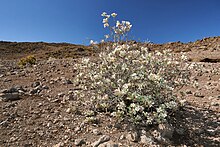| Geranium cuneatum | |
|---|---|

| |
| Geranium cuneatum growing at 3200m elevation on Mauna Kea | |
| Conservation status | |
 Vulnerable (NatureServe) | |
| Scientific classification | |
| Kingdom: | Plantae |
| Clade: | Tracheophytes |
| Clade: | Angiosperms |
| Clade: | Eudicots |
| Clade: | Rosids |
| Order: | Geraniales |
| Family: | Geraniaceae |
| Genus: | Geranium |
| Species: | G. cuneatum |
| Binomial name | |
| Geranium cuneatum Hook. | |
Geranium cuneatum, or silver geranium, is a medium alpine shrub endemic to the islands of Hawai'i and Maui, where it grows in high elevation shrubland near or above the treeline. Like other geraniums native to Hawai'i, it is known as hinahina in Hawaiian.
Taxonomy
Four varieties of G. cuneatum have been described, one of which is found only on the higher slopes of Haleakalā.
Description
Geranium cuneatum is a many-branched shrub growing 30–100 cm high. Leaves are green or gray and are covered with small hairs for reflecting sunlight. Flowers are white, sometimes with purple veins.
Distribution and habitat
Geranium cuneatum is endemic to high elevations on the slopes of the volcanoes Mauna Kea, Mauna Loa, Hualālai, and Haleakalā. It is frequently encountered above the tree line and grows up to at least 3200m elevation on Mauna Kea and Haleakalā.
References
- "NatureServe Explorer 2.0". explorer.natureserve.org. Retrieved 2023-08-04.
- ^ "Geraniums at Haleakala". National Park Service. Retrieved 2023-08-04.
- ^ "Flora of the Hawaiian Islands". National Museum of Natural History. Smithsonian Institution. Retrieved 2023-08-04.
- Pax, Denise L.; Price, Robert A.; Michaels, Helen J. (January 1997). "Phylogenetic position of the Hawaiian geraniums based on rbc L Sequences". American Journal of Botany. 84 (1): 72–78. doi:10.2307/2445884. ISSN 0002-9122.